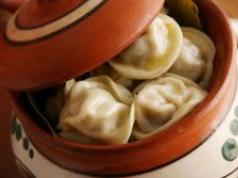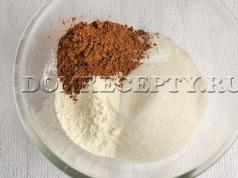This delicious Japanese dessert is prepared like this:
1. Fresh wormwood leaves are washed.
2. Boil water in a small saucepan. Add wormwood and boil for 1-2 minutes. Allow the leaves to cool.
3. Meanwhile, prepare the anko bean paste and place the balls of it on the foil. You need to prepare 12 balls. For this:
- the beans are washed and placed in a pan;
- pour water to the top of the beans and bring to a boil;
- then reduce the heat, cover the pan with a lid and cook for an hour until the beans become soft;
- when the water evaporates, add more water - the beans should always be covered with water;
- pour the broth from the finished beans into a separate bowl;
- a small handful of beans is set aside, the rest of the beans are crushed and rubbed through a sieve;
- add sugar and set aside whole beans to the bean puree, mix thoroughly;
- cook the resulting mass in a saucepan over low heat for 10-15 minutes until it acquires a dark brown or maroon color;
- when the bean mass becomes too thick during cooking, add the decoction left after the previous cooking;
- the finished anko paste is left to cool.
4. Beat the wormwood leaves along with 3/4 of the decoction with a blender until smooth.
5. Strain the mixture from the blender through a sieve into a measuring cup. Add the required portion of the remaining broth to the cup up to the 150 ml mark.
6. In a large microwave-safe bowl, combine rice flour, 200 grams of sugar, salt and rice vinegar. Add 150 ml of wormwood decoction prepared earlier and beat with a whisk until a homogeneous dough is obtained.
7. Cook the dough mochi in the microwave for 8-10 minutes on high power.
8. Mix together potato starch and 40 grams of sugar. Sprinkle some of this mixture onto the cutting board and carefully remove the hot mass - mochi - from the microwave. Sprinkle a mixture of starch and sugar on top.
9. Using the flat edge of a large knife, straighten the mochi from above and straighten the edges to form a rectangular layer.
10. Cut the mochi into 12 pieces.
11. Roll out each part and place the filling in the center - a ball of red bean paste. Lift the edges of the mochi up and press them tightly, sprinkle the sealed edges with a mixture of starch and sugar. Turn the ball over and place it on a cutting board sprinkled with a mixture of starch and sugar.
12. The finished wrapped mochi with filling is coated with soy flour.
13. Serve immediately warm or store mochi in the refrigerator until serving, covered with plastic wrap. This dessert can be stored for 2-3 days.
14. Yomogi Daifuku from the refrigerator is heated in the microwave until soft before use.
Bon appetit!
Welcome, friends, to the susi-college website!
Here you will find another Japanese sweets, namely very original rice sweets with fruits - daifuku (daifukumochi). In this article you will find a detailed recipe and, as usual, interesting facts for general development. This time there will be no talk about equipment such as rice cooker, sushi oven, etc. Let's learn to cook!
What is daifuku?
Daifuku (Daifukumochi) are traditional Japanese wagashi sweets, which are small rice cakes filled with sweet beans.  paste or melon paste with whole fruit. I wonder what daifuku
literally translated from Japanese as great luck.
paste or melon paste with whole fruit. I wonder what daifuku
literally translated from Japanese as great luck.
Such Japanese sweets can be very different in shape, size and color, as well as different in content. Daifuku sweets are palm-sized or very small, about 3 cm in diameter. They also come in different colors: white, pink, light green, etc.
The story of daifuku.
Interestingly, Japanese daifuku sweets were previously called by another name - harabuto mochi, which literally translated from Japanese means - mochi sweets with a fat belly. And indeed, the fruit filling makes the sweets look pot-bellied. It’s also interesting that in Japanese the words “belly” and “wealth” are synonymous.
 To prepare daifuku you will need:
To prepare daifuku you will need:
- 200 grams glutinous rice flour
- 50 – 60 grams of sugar
- 150 ml water
- a little potato or corn starch for dusting
For filling:
- 120-150 grams of finished anko -
- 6 strawberries or any other
your discretion (you can also use dried fruits - dried apricots, prunes, etc.). If you don’t have any fruit at home, you can make dessert without it. For example, we tried making daifuku simply with anko and it was also very tasty!
Stage one:
 First, rinse and dry the berries; if you decide to use dried fruits, then soak them for 8-10 minutes in warm water so that they swell. Then divide the prepared anko bean paste into 6 equal parts and roll into balls. You can see how to prepare anko paste in one of these recipes:,. The filling is ready, now let's move on to preparing the rice dough for our daifuku.
First, rinse and dry the berries; if you decide to use dried fruits, then soak them for 8-10 minutes in warm water so that they swell. Then divide the prepared anko bean paste into 6 equal parts and roll into balls. You can see how to prepare anko paste in one of these recipes:,. The filling is ready, now let's move on to preparing the rice dough for our daifuku.
Stage two:
First of all, heat 150 ml of water in a bowl and dissolve the sugar in it. Afterwards, let the syrup cool slightly so that it is not hot. Then place 200 grams of rice flour in a separate bowl. And while stirring, pour in the resulting syrup. Now place the rice dough in the microwave or conventional oven for 2 minutes. Then mix the dough thoroughly and put it back in the oven until it begins to rise and become transparent. When the dough has puffed up and become thick, remove from the oven and stir with a wooden spoon or spatula.
Stage three:
 Take a metal tray or other flat dish that can withstand heat and lightly sprinkle the bottom with potato or cornstarch. Also sprinkle starch on your hands to make it easier to place the resulting rice dough on a tray or dish. Then divide the rice dough into 6 parts (do this carefully so as not to burn your hands on the hot dough) and form flat round cakes, sprinkling them with starch so that they stick better to your hands and take the desired shape.
Take a metal tray or other flat dish that can withstand heat and lightly sprinkle the bottom with potato or cornstarch. Also sprinkle starch on your hands to make it easier to place the resulting rice dough on a tray or dish. Then divide the rice dough into 6 parts (do this carefully so as not to burn your hands on the hot dough) and form flat round cakes, sprinkling them with starch so that they stick better to your hands and take the desired shape.
Stage four:
The process described below must be performed at a fast pace while the dough is hot and stretchy (flexible)!!!
Take your chosen berry and one anko ball (bean paste). First press the berry into the anko ball and then stretch the paste around the berry. Now place the filling in the form of a ball - in the middle of the rice round cake. And using the same principle, stretch the rice dough around the filling, forming ready-made daifuku balls. Then carefully place all the resulting daifuku balls on a tray or dish, seams down, so that all the Japanese sweets look especially beautiful and sprinkle starch on top.
Japanese dessert daifuku Mochi (or simply daifuku) is a pastry made from glutinous rice paste with a filling.
The filling for daifuku can be any sweet paste, such as sugar and honey, and the filling is often supplemented with various fruits and berries. Today we will offer you daifuku with a completely exotic filling - jackfruit slices.
In Japan, for cooking daifuku Mochi uses rice flour - "mochiko" and azuki bean paste - "anko". Such specific ingredients can be found in Japanese grocery stores, but they can be successfully replaced with more familiar ones.
For the filling we will use peeled jackfruit slices, chocolate nut butter and crushed biscuits. But in fact, the composition of the filling is limited only by the cook’s imagination.
Prepare mochi (rice cakes):
- In a container, mix together rice flour, sugar and a small amount of water.
- Cover the container and heat over high heat for 1 minute, remove and stir. Repeat the process two to three times until the dough becomes transparent.
- Place the dough on a work surface sprinkled with potato starch. Sprinkle it with starch on top, and also cover the rolling pin and hands with starch. When the dough has cooled a little, roll it out using a rolling pin. And cool it in the refrigerator for 15 minutes.
- Remove the dough from the refrigerator. Using a cookie cutter, cut out circles (can be any shape) and place on a plate. Knead the remaining dough, roll it out and cut out circles from the dough again. In total you should get about 8-10 mochi circles.
Preparing the filling:
- Grind the cookies in a container and mix with chocolate-nut butter. Or use Anko paste.
- Spread the paste in an even layer over the surface of the mochi.
- Place a slice of jackfruit in the middle and, pressing the edges of the circle, wrap the pasta with dough. Sprinkle the sticky areas with potato starch and seal the cracks. We are preparing other Daifuku Mochi.
Serve to the table:
- Place the finished daifuku mochi in the refrigerator for 30 minutes. Then serve from the table. Bon appetit!
Ice cream can be used as a filling. In this case, ready daifuku Mochi must be stored in the freezer.
Mochi is a traditional Japanese flatbread. Mochi is made from a special type of mochigome glutinous rice crushed into a paste, which acquires a sweet taste when chewed for a long time. The traditional process of creating such flatbreads is called mochitsuki. Mochi is eaten throughout the year, but the greatest demand for this dish occurs on New Year's Eve, when the Japanese customarily distribute this delicacy to all relatives and neighbors. It is believed that when a person eats mochi, he experiences divine grace.
Mochi is made from round-grain matte rice of the mochigome variety. Rice of this variety becomes dense and sticky after heat treatment. Traditionally, mochi is made by hand. The ceremony of making mochi in Japan is called mochitsuki and consists of several stages.
Polished glutinous rice is soaked overnight and boiled or steamed.
Boiled rice is pounded with a wooden hammer in a traditional mortar (usu). This process involves two people, alternately replacing each other. One of them crushes the mochi, and the second stirs and wets it.
The resulting viscous dough-like mass is given a certain shape - spherical or cubic, or it is formed into flat cakes, which are grilled or boiled.
Mochi can also be made from flour and sweet rice (mochiko). Flour is mixed with water until a sticky, opaque white mass is obtained. Next, this mass is cooked to an elastic translucent state in a conventional or microwave oven.
Mochi is used to make many types of traditional Japanese sweets (wagashi and mochigashi). For example, daifuku is a soft, round mochi with a sweet filling such as red (an) or white (shiro an) bean paste. Ichigo daifuku has strawberry filling. Kusa mochi is a type of green mochi with tansy (yomogi) flavor. Daifuku made from kusa mochi is called yomogi daifuku. Additionally, small scoops of ice cream are wrapped in mochi to create mochi ice cream.

"Daifuku Mochi"
Ingredients:
300 grams (2 cups) glutinous rice flour (called Mochiko in Japan)
350 grams (1½ cups) water
150 grams (¾ cup) sugar
1 teaspoon (¾ volume) vanilla
2.5 tablespoons corn syrup
A little potato starch to prevent the dough from sticking
The filling can be traditional azuki bean paste or anything else you like.
You can make your own gluten rice flour by finely grinding the appropriate type of rice and adding corn syrup, which will serve as a thickener and sweetener.

Step one:
To prepare the dough, you can use either a gas stove or a microwave oven. Leave the mortar and hammer for later.
For microwave oven- mix all the ingredients (except for starch and filling) in a glass container suitable for heating. Cover the dish (preferably with cling film) and place in the microwave at the highest available power for about 2 minutes. After this, mix the substance and put it in the microwave for another 4 minutes.
For gas stove- pour water into a medium-sized saucepan, let it boil, and leave on “medium heat.” Add sugar, vanillin and corn syrup to the water, stirring until they are completely dissolved. Add flour in small portions, stirring constantly: you need to achieve a homogeneous consistency. Once the result is achieved, remove from heat.

Step two:
Place the resulting mass on a surface previously sprinkled with starch. We do not skimp on starch so that the dough does not stick. The dough must be divided into 20 equal pieces, each of which will need to be rolled out to a flat pancake. The filling is laid out on the pancake, the pancake is closed like a bag by “pinching”.
Step three:
It is advisable to lightly roll the finished product in starch so that it does not stick to your fingers, and then place it on a plate with starch.
Mochi with ice cream inside
You just need to put a teaspoon of ice cream inside and immediately put the product in the freezer for a couple of hours. Mochi should be removed from the freezer a few minutes before serving. All surfaces will also need to be sprinkled with starch to prevent the mochi from sticking.








